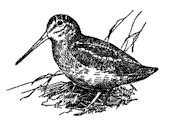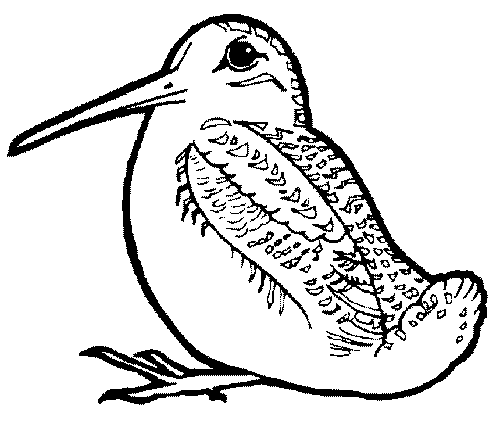

North American Woodcock Singing-ground Survey
Instructions
 |
|
 Please follow the below instructions closely so that data from your route will
be of maximum value. The quality of the survey depends on you. (Note,
these instructions are located on the back of your survey
form or accompany it.)
Please follow the below instructions closely so that data from your route will
be of maximum value. The quality of the survey depends on you. (Note,
these instructions are located on the back of your survey
form or accompany it.)
Please use the survey form given to you by your state or provincial coordinator. If this is not possible, you may download a blank survey form.
These downloadable versions of the survey form are in a PDF format. You will need the free Adobe Acrobat Reader to download the forms.
Survey protocol requires that whenever possible the same observer should run the same route each year. If it is known that a new observer will take over next year, both observers (old and new) should run the survey together this year, if possible, to allow for one year of overlap. New observers should complete the survey with the previous observer on the same day at the same time, however both should collect and submit data independently (observers should ride together in the same car, but collect data on separate survey forms, and not discuss what they hear or compare results). This will ensure that the new observer learns survey procedures and local route conditions. Further, because observer data are used as covariables to adjust for differences in observers’ ability to hear woodcock, and the approach used to calculate the 2 year population trend requires at least 2 non-zero counts by at least one observer, overlapping new with previous observers will ensure that route data qualifies for the 2 year comparison. If a year of observer overlap is not possible, data collected by a new observer is still valuable and will still qualify for the long term trend analysis.
See the survey map to determine survey dates in your area. When spring weather is early or late, contact the North American Coordinator for permission to conduct routes up to 5 days outside the survey period. We encourage cooperators to run survey routes early within their survey window.
Correct timing is the key to valid data! Calculate the start time for your survey date using the provided local sunset times and the formula below. Record the sunset time for the survey date on the survey form. If the sky is clear or up to and including 3/4 overcast, add 22 minutes to the sunset time to determine the starting time. Or, add 15 minutes if the sky is more than 3/4 overcast. Example: If sunset = 8:30, and it is more than ¾ overcast, start at 8:45. If it is ¾ or less overcast, start at 8:52. If your judgment dictates variation from this timing, as in the case of deep valleys, clearly explain under "Remarks." Do not use military time (see conversion table). If sunset times are not provided, consult https://www.esrl.noaa.gov/gmd/grad/solcalc/. If you use an alternate or media sunset time source please write your source on the survey form as your start time calculations will be verified accordingly.
 Procedure
ProcedurePlan to arrive at stop 1 (the start = 0.0 mi/km) of your route at or shortly after local sunset. Using the Trip Odometer makes recording and data entry much easier. When the start time approaches, shut off your vehicle's engine and step several feet away. At the start time, record the time on your survey form and commence listening for woodcock. Listen for 2 minutes and record the number of different woodcock heard "peenting.” Then proceed rapidly 0.4 miles (0.6 km) to stop 2 and repeat the procedure at each subsequent stop through stop 10 (3.6 mi/5.4km). If a temporary hazard prevents stopping within 100 feet (.03 km) of the 0.4 mile (0.6 km) mark, proceed to the next stop and note "no stop-temporary hazard" in the space for the stop omitted. If the hazard is likely to be permanent, note “no stop-permanent hazard,” contact your coordinator, and begin to review relocation guidance. Be sure to check the survey form's box that indicates if your odometer readings are in miles or kilometers. SGS routes must be completed in the allotted time period (38 minutes). Therefore, begin listening for woodcock at stop 10 no later than 36 minutes after the time at stop 1. This ensures that the survey is conducted during the peak activity period of "peenting" male woodcock. Survey procedures allow for 2 minutes of listening/recording time at each stop, and an additional minute for travel time in between stops. If a traffic hazard prevents you from listening at a stop or completing the survey route within the specified amount of time, please clearly explain the reason in the remarks column.
Only record the number of different "peenting" woodcock. Do not record birds you hear performing only the flight song, and do not record the number of "peents" heard. When no birds are peenting, record "0" in the appropriate column. When disturbances at a particular stop make a count absolutely impossible, note the type of disturbance and proceed to the next stop. Upon completion of the route, record the total number of birds heard.
| Disturbance | Description | Example |
| NO | No appreciable effect on count. | Occasional crow calling. |
| LO | Slightly affecting count. | Distant tractor noise. |
| MOD | Moderately affecting count. | Intermittent traffic. |
| HI | Seriously affecting count. | Heavy-continuous traffic. |
Do not run routes when the temperature is below 40° F (5°C), in heavy precipitation or strong wind.
Normally, conduct a route only once during the specified period. However, if weather or other factors cause invalid counts at five or more stops the route should be rerun and data recollected on another evening.
Woodcock Survey
US Fish & Wildlife Service
Division of Migratory Bird Management
11510 American Holly Drive-Merriam Bldg.
Laurel, MD 20708Field survey forms are an essential component of our data edit-checking process and become part of our survey archive.
Your cooperation in this important survey is greatly appreciated. About mid-August you can view and print the results of this year's singing-ground survey online. Go to https://www.fws.gov/library/collections/american-woodcock-population-status-reports.
You can also query and download Woodcock SGS route level data (1968-2015) at https://migbirdapps.fws.gov/. For 2016 to present, please contact the North American Woodcock Coordinator directly.
You will need the free Adobe Acrobat Reader Get Acrobat Reader to download the report.

|
|
Last Updated: Please direct website questions/comments/survey related inquiries to WeblessSurveyCoordinator@fws.gov, USFWS, Division of Migratory Bird Management.
NOTICES
PRIVACY ACT STATEMENT
Authority: The information requested is authorized by the Migratory Bird Treaty Act (16 U.S.C. 703-712).
Purpose: The contact information is requested in case verification is needed about submitted observations of the North American Woodcock Singing Survey.
Routine Uses: The contact information may be used by the State or Provincial Coordinator or staff from the Division of Migratory Bird Management to verify the results from the survey. More information about the routine uses may be found in the Systems of Records Notice, FWS-26 Migratory Bird Population and Harvest Systems.
Disclosure: The contact information requested in this form is voluntary.
PAPERWORK REDUCTION ACT STATEMENT
We are collecting this information subject to the Paperwork Reduction Act (44 U.S.C. 3501) in order to estimate woodcock relative abundance and to respond to requests made under the Freedom of Information Act and the Privacy Act of 1974. Your response is voluntary. According to the Paperwork Reduction Act of 1995, an agency may not conduct or sponsor, and a person is not required to respond to a collection of information unless it displays a currently valid OMB control number. OMB has approved this collection of information and assigned Control No. 1018-0019.
ESTIMATED BURDEN STATEMENT
Public reporting for this collection of information varies with the convenient availability of the requested information. The relevant burden to complete the survey averages 1.75 hours, including reviewing instructions, map and training presentation, drive to and from the survey route, gather data at survey stops, and complete and review the survey form. Direct comments regarding the burden estimate or any other aspect of the form to the Service Information Clearance Officer, Fish and Wildlife Service, U.S. Department of the Interior, 5275 Leesburg Pike, MS: BPHC, Falls Church, VA 22041-3803. Please do not send your completed form to this address.